WE RIDE RYAN VILLOPOTO’S AMA?NATIONAL KAWASAKI KX450F… BECAUSE HE DIDN’T GET TO

Q: HOW DID WE GET OUR HANDS ON RYAN VILLOPOTO’S FACTORY BIKE?
A: MXA had the bright idea of inquiring about testing Ryan Villopoto’s KX450F, because, like most factory bikes that we throw a leg over, the rider of interest was injured. Believe it or not, we didn’t have to trade our souls or offer our first-born child to Kawasaki for the opportunity. Villopoto’s bike was sitting in the corner of Kawasaki’s race shop collecting cobwebs. Naturally, Kawasaki’s marketing department wanted publicity since their star rider was sidelined with a blown left knee. Being the vultures that we are, we jumped at the opportunity to test the bike of a fallen rider. It was a win-win for both parties.
Q: HOW MUCH DIFFERENT IS THIS BIKE FROM THE KX450F RYAN RACED AT THE END OF THE 2011 450 NATIONALS?
A: Given that Villopoto hadn’t done much outdoor testing before the 2012 Nationals began, the bike we tested was quite similar to what Ryan started riding at Unadilla last year. He had done a few outdoor tests before getting hurt at the Seattle Supercross, and based on last year’s Nationals, they had a solid baseline setting ready for the 2012 AMA Nationals. The engine was revised for more bottom-end power, and the Kayaba suspension was tweaked, but Ryan was very content with the 2012 KX450F from the get-go.
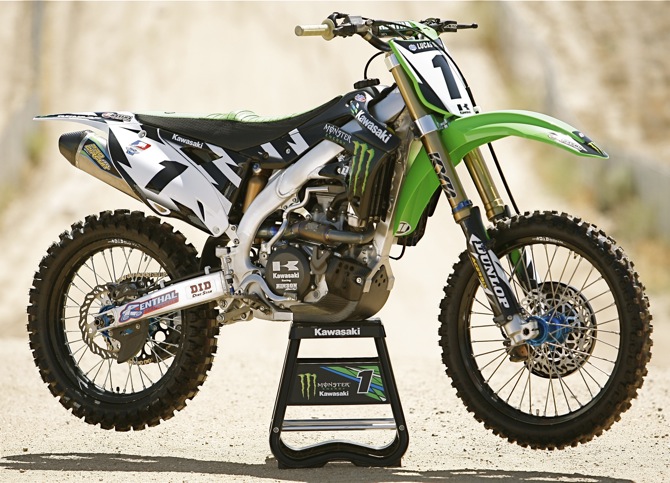
Ryan’s factory KX450F didn’t get to race a lap in anger during the AMA 450 Nationals because of Ryan’s Supercross injury.
Q: HOW DID WE TEST VILLOPOTO’S NATIONAL BIKE IF HE NEVER RACED A NATIONAL ON IT?
A: There’s the rub. Since Ryan corkscrewed his knee into the ground at Seattle, the bike we tested wasn’t officially his AMA 450 National race bike. However, Team Kawasaki was confident enough to feel that they were handing us the 2012 Kawasaki KX450F that Ryan would have taken to the gate at the first AMA National?with the caveat that there were a few parts missing.

Q: WHAT PARTS WERE MISSING?
A: It would take a critical eye to discern Ryan Villopoto’s test bike from the full-blown race machine. Here is the list.
(1) We immediately noticed that the rear brake pedal was missing a brake snake (a must-have item on any National bike).
(2) Kawasaki’s staff pointed out that the footpeg mounts are titanium on the race bike.
(3) Kawasaki didn’t put the carbon fiber fork guards on for our test; we used plastic instead.
(4) And, for the sands of Southwick, Villopoto relies on a carbon fiber gas tank. The larger tank holds an extra liter of fuel (it should be noted that Ryan uses the stock plastic gas tank at every other National track).
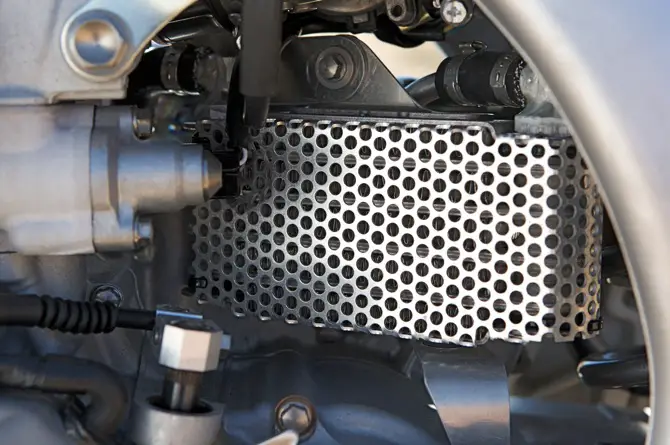
The screen protects Kawasaki’s works oil cooler.
Q: WHAT’S THE MOST UNIQUE PART ON VILLOPOTO’S KX450F?
A: The bike itself is pretty unique, but every MXA test rider zeroed in on two specific areas.
(1) Oil cooler. Located behind the engine, the oil cooler stands out like a sore thumb. It’s not uncommon for race teams to use oil coolers to lower the engine’s internal temperature, but the way Kawasaki routed the oil cooler is unique. Typically, an oil cooler sits directly behind the radiator, but the race team discovered that the location prevented the radiator from cooling properly. And, no surprise, blocking the airflow from the radiator didn’t maximize the cooling effect for either the water or oil. So, Kawasaki moved the oil cooler away from the radiator and exhaust header for greater cooling efficiency.
(2) Transmission. The second unique part took a bit of deduction on our part. When asked about the gearing combination that Villopoto prefers, Kawasaki’s mechanics smirked, knowing full well what our reaction would be. They replied, “Ryan runs a 13/54 combination at nearly every track?Supercross and outdoors.” That bit of information made our heads spin. A 13/54 sprocket combo is preposterous, considering that a stock KX450F comes with 13/50 gearing. It doesn’t take a genius to understand that Kawasaki had seriously overhauled the transmission. Coming directly from KHI, the transmission has a significantly taller first gear, which is closer to second and third gear. Fourth- and fifth-gear ratios are relatively similar to what would be found on a stock bike.
Q: WHAT’S THE DIFFERENCE BETWEEN KHI AND KMC?
A: KHI, or Kawasaki Heavy Industries, is the designation for Kawasaki’s factory in Japan. KMC, or Kawasaki Motors Corp., is Kawasaki’s division in the United States. Years ago, most of the factory trinkets came from KHI in Japan. Now, the race team makes the majority of their one-off parts at KMC. The parts made at KMC are often cheaper than what comes from Japan. There’s also the benefit of a quick turnaround time on making one-off parts.
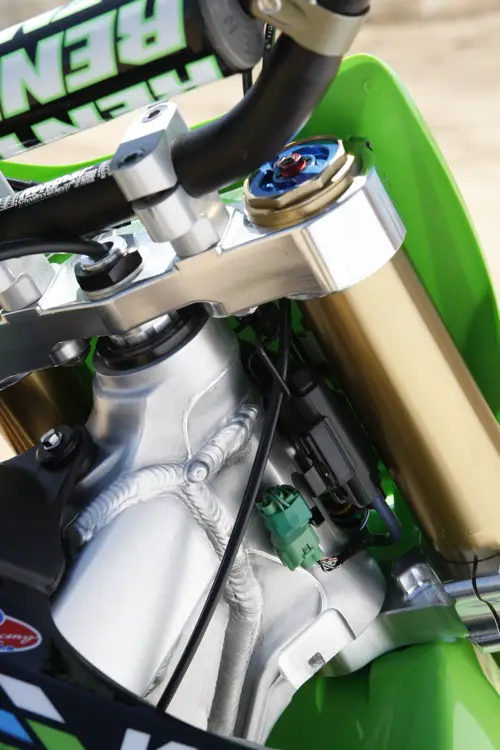
Kawasaki runs CNC-machined billet clamps with 24mm offset on Ryan’s bike.
Q: WHAT PARTS ARE KHI AND WHAT PARTS ARE KMC?
A: Ryan Villopoto’s KX450F comes with a special transmission, brake rotors, hubs, bar mounts, titanium bolts, magnesium front brake caliper, brake pads, hubs, steering stem, clutch plates, modified ECU, oil cooler and clutch arm provided by KHI. Kawasaki’s race staff is proud of the KMC parts that they have developed. The list includes the 50mm Ti footpegs, 24mm offset triple clamps, carbon fiber chain block, shock bell crank, shock pull rod, aluminum throttle tube, modified shifter (with a bracket to prevent mud from packing inside the pivot), high-compression piston, cylinder head, rod, crank, aluminum air filter ring, oil cooler adapter, and nearly all of the carbon fiber parts. The team intends on making more of their own parts in the future. The race team also focuses on strengthening areas on Villopoto’s KX450F. The radiators have been reinforced at the tanks and spigots for greater durability, and gussets have been welded to both sides of the swingarm for improved stability. There is also a washer placed between the engine case and shifter to prevent the shift shaft and case from breaking upon impact. This part was added after Tim Ferry hit a hay bale at Southwick in 2007. No stone is left unturned.
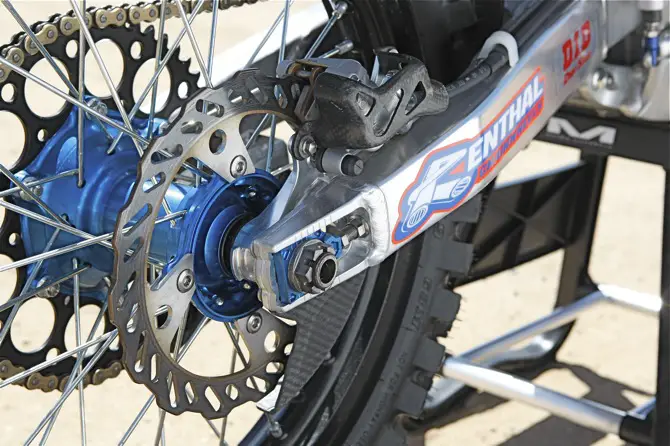
Q: ARE THERE PARTS THAT ANYONE CAN BUY OFF RYAN VILLOPOTO’S BIKE?
A: Yes, but don’t get too excited. Since this is a factory bike, most of Ryan’s bike is off limits. Just as with any team, the Monster Energy Kawasaki fleet relies on aftermarket companies. You can purchase Ryan’s Renthal TwinWall 998 handlebars, Kevlar grips and sprockets, D.I.D. chain, DirtStar LT-X rims, One Industries graphics and pleated seat cover, Acerbis plastics and carbon fiber front rotor cover, ARC levers and two-pin holeshot device, VP Racing MR-Pro 6 fuel, UNI air filter, Maxima oils, Moto Tassinari Air4orce intake system, and NGK spark plug. What about the Hinson clutch? Not for sale. The Pro Circuit titanium exhaust system? It’s proprietary to Kawasaki. The Dunlop works tires and the rear foam mousse? Sorry. It’s interesting that several of the high-profile aftermarket parts that Kawasaki uses are made specifically for the team and not sold to the public.
Q: WHAT ARE?RYAN’S SETTINGS?
A: Ryan Villopoto’s settings aren’t one of the deep mysteries of the world. Since Ryan is not that tall, it’s understandable that Kawasaki lowered the subframe by 7mm to prevent the seat from slapping him in the bumps. The bar mounts, although standard height, are moved 5mm back. The footpegs are mounted in the up position. Ryan is a bit quirky. Due to a lingering wrist injury from long ago, Villopoto aims his front brake lever higher than his clutch. And, in what is the most unusual placement for a seat hump that we’ve ever come across, RV has a tuft of foam placed dead center in his seat. As for the engine, Ryan prefers a lot of power. That much was evident when we tested his Mitch Payton-built Pro Circuit Kawasaki KX250F in 2007. Villopoto did request a smooth and metered hit off the bottom to prevent the rear wheel from losing traction. Kawasaki’s personnel paid close attention in getting Ryan exactly what he wanted. An interesting note: Jake Weimer and Villopoto prefer the same engine package.
Kaipo Chung is the in-house suspension technician in charge of handling Ryan’s needs. When asked about RV’s suspension preferences, Kaipo said, “Ryan doesn’t want the bike to move, but he does want a certain level of comfort. He wants to be able to attack the track. It’s nice that we don’t make very many extreme suspension changes on race day. Ryan rides during the week with a certain setting, and he becomes comfortable with it. We might make a click or two here or there, but that’s about it. We do all of our homework on test days during the week. And when we test, he relays his thoughts on how the bike feels. He doesn’t tell me what needs to be changed. If a rider is telling me how to go about fixing the suspension, then he shouldn’t be racing, especially at a National level. A lot of riders try to really tweak the bike, but often they make too drastic of a change. Ryan is a ?feel’ guy.”

Q: WHAT’S IT LIKE TO RIDE RYAN VILLOPOTO’S FACTORY KAWASAKI KX450F?
A: Ah, yes, the answer everyone wants to know. Before we go into vivid details about Villopoto’s KX450F, we offer a warning: contrary to popular belief, test riding a factory rider’s bike isn’t all rainbows and kitty cats. It may seem like a dream to ride a bike that one of the fastest riders in the world pilots?that assumption couldn’t be further from the truth. Testing a factory bike is like strapping yourself to a rocket. It’s not a coincidence that “dummy” follows the word “test.” You need to be a little bit crazy to believe that you could harness the power of a bike designed for the most talented rider in the world. In all honesty, Ryan Villopoto’s KX450F scared our test riders. It’s a bike that requires riding at full tilt, without regard for life or limb, in order to work effectively. The speed needed to make Ryan’s bike work to its fullest is well within his comfort window?it was out of ours. Even our AMA Pro-level test rider admitted to being leery of attacking the track, because he didn’t feel comfortable in the least bit. It wasn’t until he committed to the idea of going fast at the expense of crashing that the bike started to mold to him. MXA likes to have test riders of as many skill levels as possible test bikes, and Ryan’s bike was no different. Our slower test riders may have had visions of grandeur about how fast they could go on a full-blown works bike, but, in truth, they refused to push the limits far enough to take advantage of what was available. Why? Blame it on a lack of talent, speed or stupidity, but they considered it intelligence.
Q: DOES THIS MEAN THAT VILLOPOTO’S ENGINE WAS EXPLOSIVE?
A: That’s the weird thing; it was incredibly powerful, but Villopoto’s engine felt slower than a stock KX450F in the nether regions of the powerband. How can that be? Team Kawasaki’s concept was that smoother is better than raw bottom-end hit. Instead of the rear wheel breaking traction and lighting up, Ryan’s bike hooked up with ease. At that point, test riders had to decide whether to yank the throttle wide open or wave the white flag. MXA test riders who had the gumption were treated to a massive surge of impressive horsepower.

Ryan’s bike demanded to be ridden at full tilt?which makes Ryan the perfect man for the job.
Q: HOW DID VILLOPOTO’S KX450F HANDLE?
A: Again, speed was a prerequisite for performance. The faster the test riders rode, the better the suspension performed. If the test rider tried to finesse his way around the track, the front end would act weird. The bike would push in corners and not feel planted. Once the speed increased, the handling came into its own. Over rough straights it was imperative to stand up and lean back to soak up the chop. Standing up is a non-negotiable requirement; otherwise, the front end will feel unplanted. The transition from standing to sitting up near the gas tank must be quick in order to get the front end to stick and not understeer.
Q: WHAT AREA OF RYAN VILLOPOTO’S BIKE TOOK GETTING USED TO?
A: Would you believe us if we said that it was the seat hump? We didn’t realize that one small piece of foam could be so obtrusive. Because the hump is smack dab in the middle of the seat, a few test riders had difficulty positioning themselves on Villopoto’s bike. Shorter riders eventually came to terms with the seat hump, but taller riders kept getting goosed every time they went to sit down. It was, shall we say, an uncomfortable sensation.
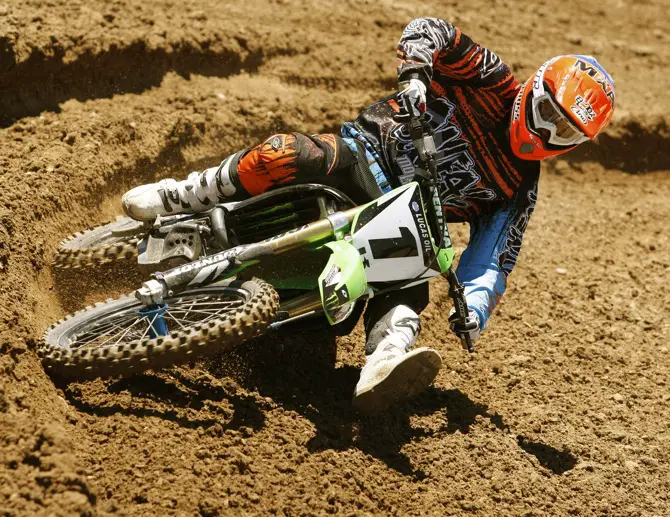
Q: WHAT DO WE REALLY THINK?
A: Having watched Ryan Villopoto ride the wheels off his race bikes and squeeze every ounce of power from his engine, we knew that Villopoto’s Monster Energy Kawasaki KX450F would be a handful. It’s apparent now that no one of lesser skill than Ryan Villopoto would be able to tame the beast. The factory KX450F requires full commitment from the rider?and that rider had better be faster than 99.99 percent of the population.





Comments are closed.